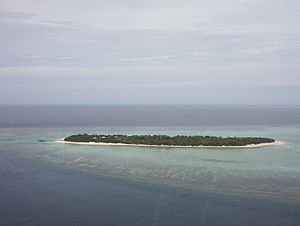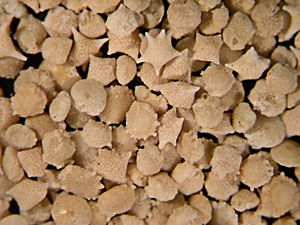Cay facts for kids
A cay (pronounced "key") is a small, flat island made mostly of sand or coral. You'll often find cays sitting on top of a coral reef in warm, tropical seas. Another way to spell it is "key," like the Florida Keys.
The word cay comes from the Spanish word cayo, which originally came from the Taíno language. Taíno was spoken by native people in the Caribbean. This is why you hear the word "cay" a lot in the Caribbean.
Cays form on the edges of coral reefs, usually on the side opposite to where the wind blows most often. This is why cays are often long and narrow. Tides and wind help build cays by dropping pieces of coral and sand onto the reef. Even sea birds can help! The weather plays a big role; strong tides can bring more material and make a cay bigger. But a powerful storm, like a tropical cyclone, can also destroy a cay.
Some cays can be quite large. For example, Cayo Coco, north of Cuba, is about 370 square kilometers! Many large cays are popular for tourism because they have beautiful white sand beaches and are close to amazing coral reefs.
How Cays Are Made
A cay starts to form when ocean currents carry loose sand and bits of coral across a reef. When the current slows down or meets another current, it drops this material. Slowly, layers of sediment build up on the reef. This usually happens on the windy or sheltered sides of the reef, sometimes around an old piece of reef or rock sticking out of the water.
The island that grows from this buildup is made almost entirely of natural materials from the reef. These are the tiny pieces of plants and animals that lived in the surrounding reef. If the island is mostly made of sand, it's called a cay. If it's mostly made of gravel, it's called a motu.
The sand on cays is mostly made of calcium carbonate. This comes from many different sea creatures and plants, like coral, shellfish, and certain types of green algae. Even tiny amounts of silicate sediment can come from sponges. Over time, soil can form on a cay, and plants can start to grow, often helped by bird droppings (called guano).
Cay Changes and Stability
Cays are always changing. Many things affect whether a cay grows or shrinks. These include how much sand is on the reef, changes in ocean waves, currents, tides, and sea levels. The shape of the reef underneath also matters, as do the types of creatures that create or break down the reef materials.
Big natural events, like strong El Niño weather patterns or tropical cyclones, can cause major changes to cays and their surrounding reefs. These storms can sometimes help build up an island, but they can also destroy it.
There's a lot of discussion about what the future holds for cays. People are concerned about how growing human populations and changes to reef ecosystems might affect them. Also, predicted sea level rise due to climate change is a big topic. Scientists are still studying whether cays are old islands that stopped growing long ago, or if they are still actively growing with new reef sediments.
Understanding how the sand and other materials that make up cay beaches might change is important for predicting if these islands will stay stable in the future. Even with all the debates, everyone agrees that cays are very complex and delicate environments.
Examples of Cays
Here are some examples of cays:
- The Florida Keys in the United States are mostly made of old coral reefs. A few, like Sand Key, are true cays.
- Heron Island, Australia, is a coral cay located on the southern part of the Great Barrier Reef.
- Prickly Pear Cays are two small, uninhabited cays near Anguilla in the Caribbean.
- Rama Cay is a small island off the coast of Nicaragua, home to the Rama people.
- Tobacco Caye is a small island in Belize, popular for snorkeling and diving.
- Warraber Island in central Torres Strait, Australia, is a small island about 750 by 1500 meters wide. It sits on a large reef platform.
- Elbow Cays are a group of small islands in the Bahamas.
Images for kids
-
Warraber Island in the Torres Strait
See also
 In Spanish: Cayo para niños
In Spanish: Cayo para niños





